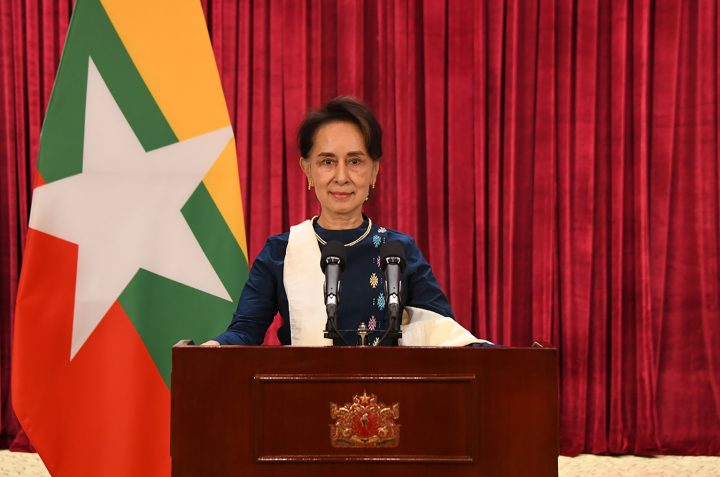21 Oct
Today is a historic and milestone day for our health sector in our country. The reason I can say this is because beginning from October 2020, HPV vaccine (Human Papillomavirus Vaccine) has been included as the 13th vaccine in the regular vaccination programme of the Ministry of Health and Sports and 450,000 young girls between the ages of 9 to 10 years will be vaccinated on a nationwide scale in the wards and villages of regions, states and townships. The HPV vaccine can prevent cervical cancer caused by the Human Papillomavirus (HPV).
Cervical cancer affects women all over the world, and it is the fourth most prevalent cancer, and this type of cancer afflicts Myanmar women the most.
According to available data, in 2018, a total of 849,569 women all over the world were afflicted with cervical cancer and 365,311 women lost their lives. It is learnt that in Myanmar, 6,472 women were afflicted with cervical cancer and 3,856 women lost their lives.
It is learnt that in Myanmar, 21 women out of every 100,000 women were afflicted with cervical cancer, and Myanmar ranks second among South-East Asian countries.
Among the viruses that cause cervical cancer, 70 per cent are caused by HPV 16 and 18; among women who have normal immunity level, cervical cancer may develop only after a period of 15 to 20 years after being infected by this virus. However, among women with low immunity level (e.g. those who have HIV), cancer can develop with 5 to 10 years. We can prevent HPV infection, which causes cervical cancer by having HPV vaccination while young. By vaccinating young women as early as possible before 15 years before they are exposed to the HPV virus, sufficient time could be given for protection; this is why the WHO – World Health Organization has urged member countries to include the HPV vaccination the regular vaccination programme as a priority. There are now 100 countries which have included HPV vaccination in their regular vaccination programmes up to August 2019.
Rich countries have been able to provide HPV vaccinations as a result of which they have been able to reduce the rate of cervical cancer occurrence. However, we have seen that poor countries have not been able to make use of this vaccine for a disease which is quite prevalent. By including the HPV vaccination in the regular vaccination programme in Myanmar, we would be able to effectively reduce the occurrence/fatalities caused by cervical cancer; furthermore, we can reduce the expenses needed for medical treatment and human resources.
From the part of the people, they will become to have more confidence in vaccination programmes because of the availability of additional potent and valuable vaccines as well as trust and acceptance; they will thus have more enthusiastic cooperation and participation to improve the coverage of current vaccinations and dispensation of medicines. This year during October and November, we will be including the HPV vaccination in the regular vaccination programme to cover the targeted age group for young girls who were born between September 2010 and August 2011; they will be vaccinated two times with a spacing of 12 months. Every year, we will collect data and provide vaccination against HPV to all the girls aged between 9 and 10. HPV vaccine price for a girl is USD4.5 per dose. The government will pay 20 per cent of the expenses while an international organization named “Gavi, the Vaccine Alliance” will pay 80 per cent. But after 2025, the government will have to pay all of the expenses.
The Central Expanded Immunization Programme section, operated under the Public Health Department of the Ministry of Health and Sports, have already made advance preparations systematically on a real-time basis, to give the vaccination to all children of the targeted age group, leaving no one behind, at the national, regional, township-level up to the rural health divisions. Similar to this central-level opening ceremony marking the vaccination period, Region/State level, and township level opening ceremonies marking the vaccination period will be held in their areas to coincide with the actual commencement of vaccination.
The objective is that all officials from the central government and regional governments, all level of public administrators, relevant departments, NGOs, local and foreign civil society organizations, and all the citizens need to know about the introduction of HPV vaccination programmes, the targeted age-group, and all other diseases that can be prevented by vaccinations; the intention is that all of them will willingly participate in the vaccination programme, and all children of the targeted age-group will receive all the vaccines they need. Moreover, we will be able to urge women between the ages of 30 and 49 to have regular cervical cancer screening and to receive necessary treatments early enough, so that the fatality rate of cervical cancer will be sharply reduced.
In conclusion, the introduction of the HPV vaccination, as 13th vaccine, in the regular vaccination programmes of the Ministry of Health and Sports is a huge investment that will bring effective benefits for the country; so I would like to urge all relevant ministries, region/state governments, administrative units, civil society organizations and all citizens to cooperate in the programme so that all children of the targeted age-group, leaving no child behind, can be vaccinated. Thank you all. May you have good health and well-being.
(Translated by Kyaw Myaing, Aung Khin)


